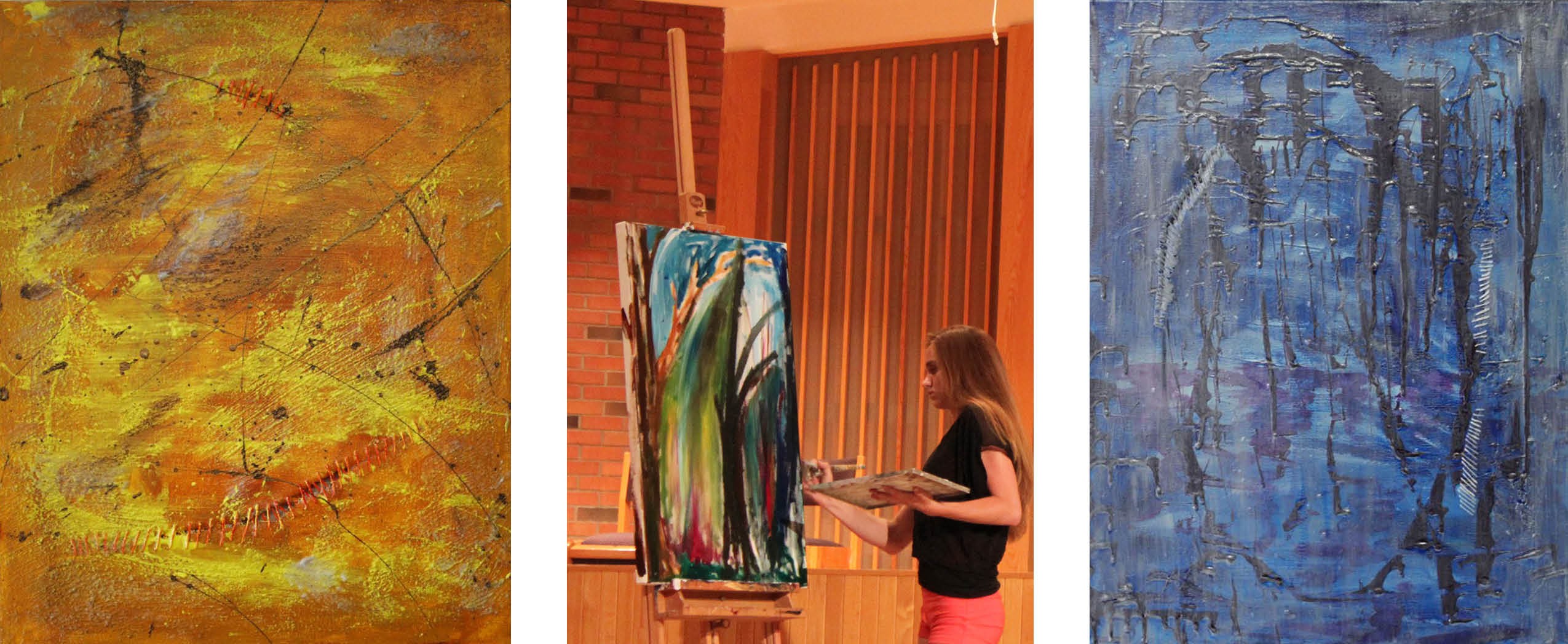
(L) Sandstorm, 2012 (M) Stephanie Peters (R) Hurricane, 2012 © Stephanie Peters
MIXED MEDIA ARTIST Stephanie Peters, who grew up on a farm in Maryland and now living in central Arizona, has always been surrounded by nature and open spaces. Inspired by her surroundings, she creates abstract compositions with texture and sculptural relief. Her body of work explores the human interaction with the natural environment. Within this context she has been especially interested in the devastating power and magnetic beauty of natural disasters.
It all started with the 2004 Indian Ocean tsunami. “I remember feeling stunned and confused as I was watching the news of this tragic disaster unfold on the television,” said Peters, who was a senior in high school at the time. She could not understand how something so big and so devastating could happen without a warning. “What can we do to help those affected heal?” she wondered.
Years later, in early 2011, Peters decided to channel this question into her artwork. At the time, she had just finished her degree in studio art and art history from the University of Arizona and was working in an art supply store. “One day we received a couple of stretched canvases that were torn and instead of tossing them in the dumpster, my manager let me keep them,” Peters explained. “I joked with my co-workers that all you had to do was stich up the canvas, and it would heal.”
That spring, as tornadoes were hitting the Midwest with a vengeance, Peters began to stitch one of the canvasses. Once it was repaired she added colors that echoed funnel clouds hitting the ground, and she used acrylic mediums to add texture and create movement. “In some ways, stitching the canvas and painting this picture—the first in my Natural Disasters series—symbolized something bigger,” Peters said. “I wanted to stitch up the survivors, repair their homes and their lives.”

(L) Volcanic Eruption, 2012 (M) Avelanche, 2012 (R) Flood, 2012 © Stephanie Peters
Natural Disasters is a collection of 12 abstract paintings inspired by the rapid increase of disasters Peters witnessed in the last decade. Each painting represents a disaster through color, line action, and material. After completion, the paintings were ripped up and stitched back together in order to symbolize how communities and the environment can heal in the aftermath of disaster. The collection deliberately does not discuss the scientific causes of natural disasters, nor does it engage in the climate change debate. Instead, it is meant to remind us of how we recover and move on. As such, it shows that something so devastating can have a positive outcome.
Peters chose an abstract style for her series to represent the surreal feeling that occurs when a disaster strikes. Because she experienced many of the disasters firsthand—an earthquake in Virginia, hurricanes in North Carolina, and sandstorms and wildfires in the Southwest—Peters knows this feeling all too well. “When you find yourself in the midst of a disaster, it seems the brain can’t compute what is going on,” Peters explained. “Because it can’t provide an appropriate response, the situation feels surreal and abstract.”
Peters acknowledges that disasters, besides being brutal and surreal, can also be breathtaking and astonishing. “When an avalanche falls, or a meteor shoots through the sky, it’s hard not to see beauty,” she said. “For that reason, I wanted this series to reflect that even in disaster, nature is beautiful.” To achieve this, Peters chose vibrant colors full of light and energy.
"I wanted this series to reflect that even in disaster, nature is beautiful"
Natural Disasters commemorates disasters and celebrates determination—of people and the environment—to heal and to move forward. The series was featured in the 2013F issue of BranD, an international art and design magazine. Her paintings were also on display at White Hills Gallery, Camp Verde, Arizona, in 2014, as part of Peters’ first solo show. Her work can be found in private collections internationally and across the United States.
Elke Weesjes Sabella is former editor of the Natural Hazards Observer. She joined the staff in December 2014 after a brief stint as a correspondent for a United Nations nonprofit. Under her leadership, the Observer was revamped to a more visual format and one that included national and international perspectives on threats facing the world. Weesjes was the editor of the peer-reviewed bimonthly publication United Academics Journal of Social Sciences from 2010 to 2013.
Weesjes Sabella also worked as a research associate for the Center for Disaster and Risk Analysis, formerly located at Colorado State University (although no longer active). In that role, she collected and analyzed data and translated research findings for a broader audience. She played a central role in finalizing the Disaster Preparedness among Childcare Providers in Colorado project, which examines all-hazards preparedness in daycares and in-home childcare across Colorado. She co-authored the report based on the first stage of the project, which was funded by Region VIII of the Federal Emergency Management Agency.
Weesjes Sabella specializes in cultural memory and neighborhood/community change in times of acute and chronic stress. She has published articles on the impact of drought on farming communities in Kansas, the effects of Superstorm Sandy in Far Rockaway, Queens, urban renewal in the Bedford-Stuyvesant neighborhood in Brooklyn, and health services for vulnerable populations in the South Bronx.
Weesjes Sabella received her PhD from the University of Sussex. Her dissertation, Children of the Red Flag: Growing up in a Communist Family During the Cold War (2012), as well as the majority of her publication record, share the common methodology of understanding culture and identity through oral history.